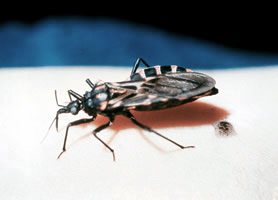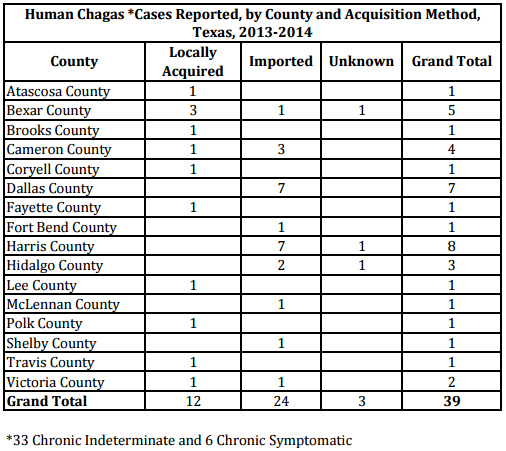Chagas disease, the parasitic infection caused by Trypanosoma cruzi, is found mainly in Latin America, where it is mostly transmitted to humans by the feces of triatomine bugs, known as “kissing bugs”.

Image/CDC
However, in several areas of the United States Chagas is ever present, according to Dr. Peter Hotez, founding dean of the National School of Tropical Medicine at Baylor College of Medicine, who told me in 2013 the number of cases of Chagas disease in the United States to be somewhere between 300,000 and 1 million. The United States is ranked 7th among nations for the amount of cases.
Texas is definitely one state that is battling the neglected tropical disease. According to Texas health officials:
In Texas, approximately 45% of the collected triatomine bugs have tested positive for T. cruzi, and Chagas is considered an endemic disease in dogs. From 2013 to 2014, 351 cases of Chagas disease in animals, primarily dogs, were reported from approximately 20% of Texas counties, representing all geographic regions of the state. Locally-acquired human cases are uncommon, but some have been reported. From 2013 to 2014, 39 human cases of Chagas disease were reported: 24 were acquired in another country, 12 were locally-acquired, and the location of acquisition was unknown for 3.
Local transmission means that the kissing bugs in Texas are infected with the parasite, causing it to spread to humans.
Chagas disease is transmitted naturally in North, Central, and South America. In parts of Mexico and Central and South America, where Chagas disease is considered highly endemic, it is estimated that approximately 8 million people are infected.

The Triatoma or “kissing” bug frequently carry for life the parasite, Trypanosoma cruzi. T. cruzi is a comma shaped flagellated parasite and the cause of an acute and chronic disease called Chagas.
The triatoma bug can be found in poorly constructed homes, with cracks and crevices in the walls or those with thatch roofs. They can also be found in palm trees and the fronds.
Usually at night while sleeping, the insect feeds on people or other mammals. While feeding the insect defecates and the infected feces gets rubbed into the bite wound, eyes abrasions or other skin wounds.
The parasite invades macrophages at or near the site of entry. Here they transform, multiply and rupture from the cells 4-5 days later and enter the blood stream and tissue spaces.
Initial infection with Chagas is typically asymptomatic. Acute disease may manifest symptoms after a couple of weeks.
Reddening of the skin (Chagoma) or edema around the eye (Romana’s sign) may be seen, albeit uncommon.
Fever, malaise, enlarged liver and spleen are part of the acute syndrome. 10% of people develop acute myocaditis with congestive heart failure. This acute disease can be fatal.
After a latent period which may last for years, the infected person may develop chronic disease (20-40%). The most serious consequences are cardiomyopathy (in certain areas it’s the leading cause of death in men less than 45 years of age) and megacolon/megaesophogus.
Trypanosoma cruzi can also be transmitted via congenital transmission (mother to baby), through blood transfusions and organ transplants, and some cases of transmission through feces contaminated food.
About 150 mammals beside humans may serve as reservoirs of the parasite. Dogs, cats, opossoms and rats are among the animals.
Benznidazole and nifurtimox are 100 percent effective in killing the parasite and curing the disease, but only if given soon after infection at the onset of the acute phase, according to the WHO.
There is no vaccine for Chaga’s, so preventive measures should include insecticide spraying of infested houses.
Robert Herriman is a microbiologist and the Editor-in-Chief of Outbreak News Today and the Executive Editor of The Global Dispatch
Follow @bactiman63
Related:
- Dengue fever: Nine additional cases reported in Hawaii, How does this compare to previous outbreaks?


It will be interesting to know if populations of the various species of triatoma bugs are moving northward as the climate warms.
What about the Texas cattle industry. Are cattle tested who have been sent to the meat market? Also what about wild game?